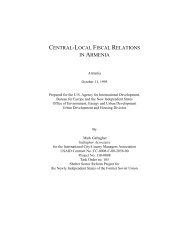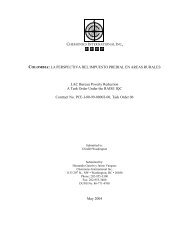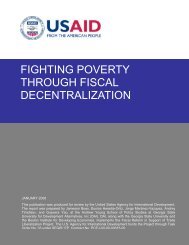Effectiveness and Economic Impact of Tax Incentives in the SADC ...
Effectiveness and Economic Impact of Tax Incentives in the SADC ...
Effectiveness and Economic Impact of Tax Incentives in the SADC ...
Create successful ePaper yourself
Turn your PDF publications into a flip-book with our unique Google optimized e-Paper software.
3-2 EFFECTIVENESS AND IMPACT OF TAX INCENTIVES IN THE <strong>SADC</strong> REGION<br />
private decisions based on free-market signals lead to an <strong>in</strong>efficient undersupply <strong>of</strong><br />
<strong>in</strong>vestment <strong>and</strong> <strong>in</strong>novation. There is <strong>the</strong>n a logical justification for government <strong>in</strong>tervention to<br />
enhance <strong>the</strong> market <strong>in</strong>centive for <strong>in</strong>vestment, research <strong>and</strong> development, <strong>and</strong> tra<strong>in</strong><strong>in</strong>g. <strong>Tax</strong><br />
breaks can be useful for this purpose.<br />
3. Practicality. Although <strong>the</strong> fundamental purpose <strong>of</strong> taxation is to raise revenue, <strong>the</strong> tax<br />
system <strong>in</strong>herently <strong>and</strong> <strong>in</strong>variably affects economic <strong>in</strong>centives. It is <strong>the</strong>refore a convenient,<br />
practical, <strong>and</strong> flexible <strong>in</strong>strument for <strong>in</strong>fluenc<strong>in</strong>g <strong>in</strong>centives <strong>in</strong> a direction that contributes to<br />
o<strong>the</strong>r policy objectives such as <strong>in</strong>vestment promotion, job creation, development <strong>of</strong><br />
disadvantaged regions, or upgrad<strong>in</strong>g <strong>of</strong> <strong>the</strong> labor force.<br />
4. Signal<strong>in</strong>g. In conjunction with o<strong>the</strong>r measures to create a welcom<strong>in</strong>g <strong>in</strong>vestment climate,<br />
<strong>in</strong>troduc<strong>in</strong>g tax breaks for <strong>in</strong>vestors can signal a country’s commitment to facilitat<strong>in</strong>g<br />
<strong>in</strong>vestment. It also provides a headl<strong>in</strong>e banner for market<strong>in</strong>g <strong>the</strong> country as a desirable<br />
<strong>in</strong>vestment dest<strong>in</strong>ation.<br />
5. Capital Mobility. In a global economy with high mobility capital, <strong>the</strong> effective tax rate on<br />
capital has to be low to attract <strong>in</strong>ward flows <strong>of</strong> foreign <strong>in</strong>vestment <strong>and</strong> keep domestic sav<strong>in</strong>gs<br />
at home to f<strong>in</strong>ance productive <strong>in</strong>vestment.<br />
6. <strong>Tax</strong> Competition. When o<strong>the</strong>r countries vie for <strong>the</strong> same <strong>in</strong>vestments by <strong>of</strong>fer<strong>in</strong>g special tax<br />
breaks, <strong>the</strong> stark choice may be to match <strong>the</strong> tax breaks or lose <strong>the</strong> benefits that may come<br />
from <strong>the</strong> <strong>in</strong>vestments, <strong>in</strong>clud<strong>in</strong>g growth-enhanc<strong>in</strong>g spillover effects.<br />
7. Compensat<strong>in</strong>g for O<strong>the</strong>r Deficiencies <strong>in</strong> <strong>the</strong> Investment Climate. A common argument <strong>in</strong><br />
less developed countries is that attractive fiscal benefits are essential to ga<strong>in</strong> <strong>the</strong> <strong>in</strong>terest <strong>of</strong><br />
<strong>in</strong>vestors who would o<strong>the</strong>rwise not consider <strong>in</strong>vest<strong>in</strong>g because <strong>of</strong> problems, such as<br />
unreliable or high cost <strong>in</strong>frastructure, macroeconomic <strong>in</strong>stability, or a weak legal <strong>and</strong> judicial<br />
system.<br />
8. Revenue Ga<strong>in</strong>s. If it is so that <strong>in</strong>vestors would go elsewhere <strong>in</strong> <strong>the</strong> absence <strong>of</strong> gett<strong>in</strong>g special<br />
tax breaks, <strong>the</strong>n <strong>the</strong> direct revenue loss from <strong>of</strong>fer<strong>in</strong>g such <strong>in</strong>centives is nil. And <strong>the</strong> <strong>in</strong>direct<br />
revenue impact can be favorable, because <strong>the</strong> new <strong>in</strong>vestments that materialize through <strong>the</strong><br />
tax <strong>in</strong>centive program will create jobs <strong>and</strong> l<strong>in</strong>kage effects that generate tax revenue.<br />
9. Political Cover. The cost <strong>of</strong> tax <strong>in</strong>centives is less visible than that <strong>of</strong> <strong>in</strong>vestment promotion<br />
policies that <strong>in</strong>volve explicit budget outlays. This argument is rarely uttered out loud, but it<br />
undoubtedly contributes to <strong>the</strong> political attraction <strong>of</strong> tax <strong>in</strong>centives, compared to alternatives<br />
that have a direct budgetary impact, such as subsidies or <strong>in</strong>frastructure development for<br />
<strong>in</strong>dustrial zones.<br />
10. Experience Shows that <strong>Incentives</strong> Can Work! Above all, <strong>the</strong> ma<strong>in</strong> argument for <strong>in</strong>vestment<br />
tax <strong>in</strong>centives is that <strong>the</strong>y have worked well <strong>in</strong> a number <strong>of</strong> countries. Exhibit 3-1 provides a











